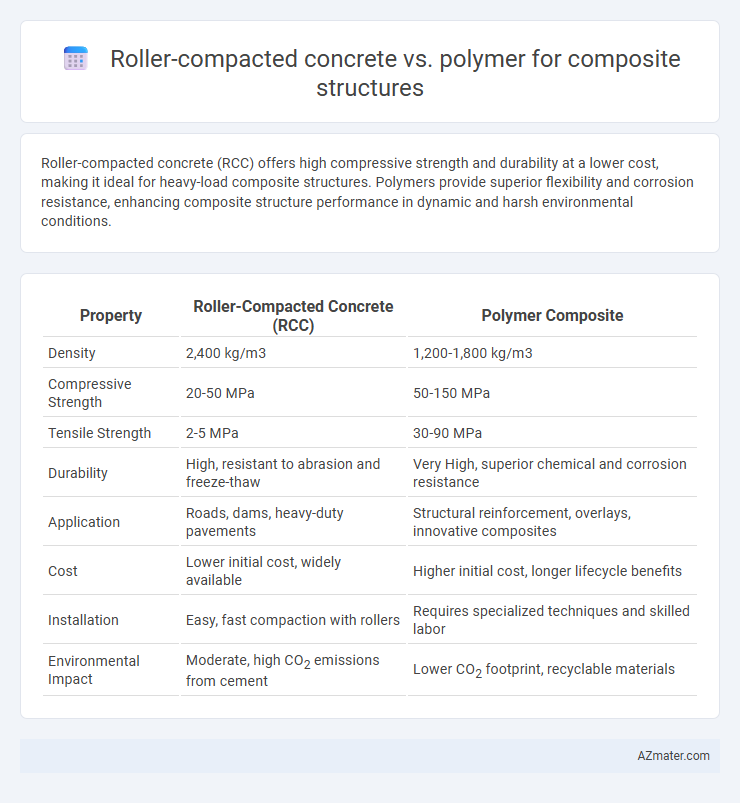Roller-compacted concrete (RCC) offers high compressive strength and durability at a lower cost, making it ideal for heavy-load composite structures. Polymers provide superior flexibility and corrosion resistance, enhancing composite structure performance in dynamic and harsh environmental conditions.
Table of Comparison
| Property | Roller-Compacted Concrete (RCC) | Polymer Composite |
|---|---|---|
| Density | 2,400 kg/m3 | 1,200-1,800 kg/m3 |
| Compressive Strength | 20-50 MPa | 50-150 MPa |
| Tensile Strength | 2-5 MPa | 30-90 MPa |
| Durability | High, resistant to abrasion and freeze-thaw | Very High, superior chemical and corrosion resistance |
| Application | Roads, dams, heavy-duty pavements | Structural reinforcement, overlays, innovative composites |
| Cost | Lower initial cost, widely available | Higher initial cost, longer lifecycle benefits |
| Installation | Easy, fast compaction with rollers | Requires specialized techniques and skilled labor |
| Environmental Impact | Moderate, high CO2 emissions from cement | Lower CO2 footprint, recyclable materials |
Introduction to Composite Structures
Composite structures combine materials to optimize strength, durability, and performance in construction. Roller-compacted concrete (RCC) offers high compressive strength and rapid placement, making it ideal for heavy-load applications within composite systems. Polymers contribute flexibility and corrosion resistance, enhancing the composite's overall resilience and extending service life.
Overview of Roller-Compacted Concrete (RCC)
Roller-Compacted Concrete (RCC) is a high-density, zero-slump concrete known for its rapid construction and excellent load-bearing capacity in composite structures. Its heavy compaction using rollers produces a durable, low-permeability material ideal for foundations, dams, pavements, and industrial floors within polymer concrete composites. RCC's cost-effectiveness, reduced curing time, and high mechanical strength make it a preferred choice over traditional polymer-based composites in large-scale structural applications.
Understanding Polymer Composites
Polymer composites in composite structures offer superior corrosion resistance and enhanced flexibility compared to roller-compacted concrete (RCC), making them ideal for applications requiring lightweight and high-strength materials. These composites incorporate polymer matrices combined with reinforcing fibers, improving durability and impact resistance under varying environmental conditions. Compared to RCC's high compressive strength and rapid placement benefits, polymer composites excel in complex geometries and areas demanding reduced maintenance over time.
Material Composition and Properties
Roller-compacted concrete (RCC) consists of a dry mix of cement, coarse aggregates, and minimal water, resulting in a high-density material with excellent compressive strength and durability. Polymer composites integrate polymers like epoxy or polyester with reinforcing fibers, offering superior tensile strength, lightweight characteristics, and outstanding corrosion resistance. The rigid, abrasion-resistant nature of RCC contrasts with the flexible, impact-resistant properties of polymer composites, influencing their suitability in composite structure applications based on load-bearing and environmental conditions.
Structural Performance Comparison
Roller-compacted concrete (RCC) offers high compressive strength and excellent durability, making it suitable for heavy-load-bearing composite structures, whereas polymer-based composites provide superior tensile strength and flexibility with enhanced corrosion resistance. RCC's structural performance excels in applications requiring significant stiffness and load distribution, while polymer composites outperform in dynamic loading scenarios due to their higher toughness and impact resistance. The choice between RCC and polymer composites depends on specific structural demands, environmental exposure, and long-term performance requirements.
Durability and Longevity
Roller-compacted concrete (RCC) offers exceptional durability in composite structures due to its high density and resistance to abrasion, making it ideal for heavy-load applications. Polymers used in composite structures provide superior chemical resistance and flexibility, enhancing longevity in corrosive environments and reducing maintenance needs. The combination of RCC's compressive strength with polymers' resistance to environmental degradation optimizes overall structural lifespan and performance.
Construction Techniques and Application Methods
Roller-compacted concrete (RCC) offers rapid, large-scale construction capabilities through heavy compaction using vibratory rollers, making it ideal for dam cores, pavements, and industrial floors, ensuring high density and durability. Polymer composites utilize advanced layering and curing techniques, including spray-up, hand lay-up, and filament winding, providing tailored strength, corrosion resistance, and lightweight structures for aerospace, automotive, and marine applications. Construction methods for RCC emphasize mechanical compaction and minimal formwork, while polymer composites rely on precise resin-to-fiber ratios and controlled curing environments to achieve optimal mechanical properties.
Cost and Economic Considerations
Roller-compacted concrete (RCC) offers significant cost advantages due to its lower material and labor expenses compared to polymer composites, making it favorable for large-scale infrastructure projects. Polymer composites, while generally more expensive upfront, provide enhanced durability and reduced maintenance costs over time, potentially lowering life-cycle expenses. Economic considerations must balance initial investment against long-term performance and maintenance when choosing between RCC and polymers for composite structures.
Environmental Impact and Sustainability
Roller-compacted concrete (RCC) offers a lower carbon footprint compared to traditional concrete due to reduced cement content and minimal water usage, making it more environmentally sustainable in large-scale infrastructure projects. Polymer composites, while lightweight and corrosion-resistant, often rely on non-renewable petrochemical resources and present challenges in recyclability, impacting their long-term sustainability. Lifecycle assessments indicate RCC structures generally produce fewer greenhouse gas emissions and offer better opportunities for reuse and recycling, positioning them as a more eco-friendly choice in composite construction.
Selection Guidelines for Composite Structures
Roller-compacted concrete (RCC) offers superior compressive strength and durability, making it ideal for heavy-load bearing composite structures requiring high abrasion resistance and thermal stability. Polymers provide enhanced flexibility, corrosion resistance, and reduced weight, suitable for applications where stress distribution and chemical exposure are critical factors. Selection guidelines prioritize RCC for infrastructure projects with high mechanical demands, while polymers optimize performance in environments needing lightweight and chemically inert composite components.

Infographic: Roller-compacted concrete vs Polymer for Composite Structure
 azmater.com
azmater.com